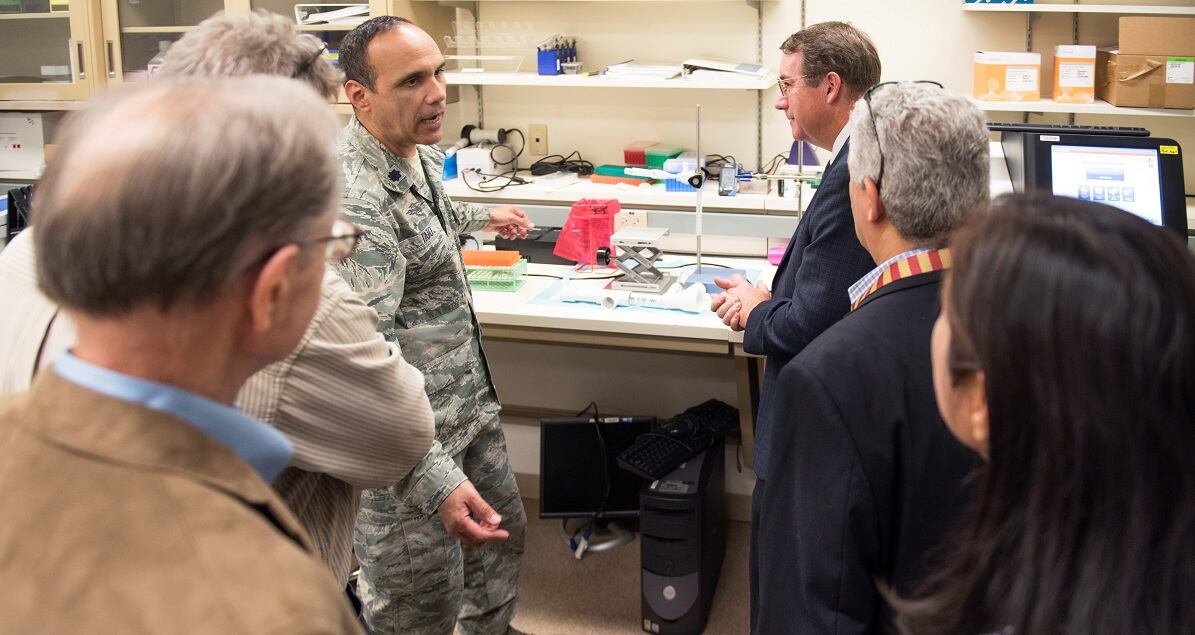Representatives from NASA recently visited David Grant Medical Center at Travis Air Force Base, California, — one of the largest hospitals in the United States — in order to establish collaboration on studying medicine for deep space exploration, as well as warfighters here on Earth.
In early June, the U.S. space agency provided a presentation on manned deep space missions and how medical researchers at Travis AFB fit into their long-term vision, according to a unit press release.
“NASA is being chartered to come up with medical capabilities for long-term exploration,” said Air Force Lt. Col. Leonardo Tato, director of the Clinical Investigation Facility, or CIF, within the 60th Medical Support Squadron. “Currently, their medical capacities are based on their mission to 230 miles low orbit.”
Manned space travel isn’t a new endeavor, but traveling beyond Earth’s orbit, for extended periods, brings new challenges, according to Dr. David Loftus, a medical officer and the principal investigator of the Space Biosciences Research Branch at NASA’s Ames Research Center in Moffett Field, California.

“Traveling to Mars and beyond are such tremendous distances from earth,” Loftus said. “That type of travel requires a whole new medical capability, which is why we are here at Travis.”
Loftus sees Travis AFB as a potential boon to space medicine research.
“With our medical technologies and their abilities to test them with real-world application through research, the partnership will be vital to our success," he said.
The collaboration between NASA and Travis is a perfect fit because of the similarities they share, said Lt. Col. Ian Stewart, a medical doctor at the 60th Medical Support Squadron.
“It’s very exciting because NASA and the military share a lot of similar problems,” Stewart said. “The ability to evacuate a casualty from an austere environment is similar to providing emergency medical care to an astronaut in space.”
NASA’s goal is to begin long-distance travel within the next 15 to 20 years, according to the press release.
“The maximum distance we travel now is 230 miles to the International Space Station,” Loftus said. “Ultimately, we’ll explore unmanned and then manned missions around the moon, then to Mars and beyond.”
The CIFs stated purpose is to provide research on technologies that improve healthcare for patients on and off the battlefield — especially research that private industry does not have economic incentive to pursue.

“We have to leverage our civilian partnerships and other government agencies to solve our unique military health capability gaps,” Tato said. “Our military mission and unique operational environment generates special medical needs, whereas civilian institutions and businesses don’t have the monetary incentive to tackle these issues as they are not in their scope of practice.”
NASA is already working in conjunction with Livermore National Laboratory at Livermore, California, to develop instruments that analyze patients through their breath and fluids, such as the E-Nose breathalyzer, which "allows you to understand the different volatile compounds in exhaled breath,” Loftus said.
“This correlates with the various compounds and the health of the patient or warfighter,” he added.
There is hope that the device will be useful on the battlefield, where troops often suffer injuries like pulmonary and traumatic brain injury from improvised explosive devices. Ideally, the device would be able to identify anomalies that point to non-visible conditions, providing faster treatment.
Kyle Rempfer was an editor and reporter who has covered combat operations, criminal cases, foreign military assistance and training accidents. Before entering journalism, Kyle served in U.S. Air Force Special Tactics and deployed in 2014 to Paktika Province, Afghanistan, and Baghdad, Iraq.




